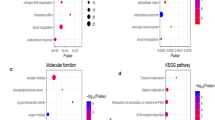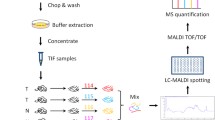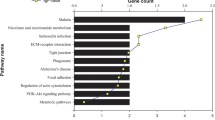Abstract
Hepatocellular carcinoma (HCC), among the most common malignancies worldwide, remains a major threat to public health, and there is an urgent need to identify novel biomarkers for diagnosis, prognosis and targets for anti-cancer treatment. In this study, two-dimensional polyacrylamide gel electrophoresis coupled with ESI-Q-TOF MS/MS analysis was used to identify differentially expressed proteins among the HCC tumour centre, tumour margin and nontumourous liver tissues. In total, 52 spots with significant alteration were positively identified by MS/MS analysis. Altered expression of representative proteins, including CIB1, was validated by Western blotting. Immunostaining suggested an increase tendency of CIB1 expression from nontumourous liver tissue to tumour centre. Knockdown of CIB1 expression by RNA interference led to the significant suppression of the cell growth in hepatoma HepG2 cells. These data suggest that CIB1 may be used as a novel prognostic factor and possibly an attractive therapeutic target for HCC.




Similar content being viewed by others
References
Cho WC 2007 Contribution of oncoproteomics to cancer biomarker discovery. Mol Cancer 6 25
Comunale MA, Lowman M, Long RE, Krakover J, Philip R, Seeholzer S, Evans AA, Hann HW, Block TM and Mehta AS 2006 Proteomic analysis of serum associated fucosylated glycoproteins in the development of primary hepatocellular carcinoma. J. Proteome Res. 5 308–315
El-Serag HB and Rudolph KL 2007 Hepatocellular carcinoma: epidemiology and molecular carcinogenesis. Gastroenterology 132 2557–2576
Farazi PA and DePinho RA 2006 Hepatocellular carcinoma pathogenesis: from genes to environment. Nat. Rev. Cancer 6 674–687
Feng JT, Shang S and Beretta L 2006 Proteomics for the early detection and treatment of hepatocellular carcinoma. Oncogene 25 3810–3817
Gentry HR, Singer AU, Betts L, Yang C, Ferrara JD, Sondek J and Parise LV 2005 Structural and biochemical characterization of CIB1 delineates a new family of EF-hand-containing proteins. J. Biol. Chem. 280 8407–8415
Gorg A, Postel W, Weser J, Gunther S, Strahler JR, Hanash SM and Somerlot L 1987 Elimination of point straking on silver-stained two-dimensional gels by addition of iodoacetamide to the equilibration buffer. Electrophoresis 8 122–124
Hwang LH 2006 Gene therapy strategies for hepatocellular carcinoma. J. Biomed. Sci. 13 453–468
Kostyak JC and Naik UP 2011 Calcium- and integrin-binding protein 1 regulates endomitosis and its interaction with polo-like kinase 3 is enhanced in endomitotic dami cells. PLoS One 6 e14513
Liu X, Cheng Y, Sheng W, Lu H, Xu Y, Long Z, Zhu H and Wang Y 2010 Clinicopathologic features and prognostic factors in alpha-fetoprotein-producing gastric cancers: analysis of 104 cases. J. Surg. Oncol. 102 249–255
Maass T, Sfakianakis I, Staib F, Krupp M, Galle PR and Teufel A 2010 Microarray-based gene expression analysis of hepatocellular carcinoma. Curr. Genomics 11 261–268
Minagawa H, Honda M, Miyazaki K, Tabuse Y, Teramoto R, Yamashita T, Nishino R, Takatori H, Ueda T, Kamijo K, et al. 2008 Comparative proteomic and transcriptomic profiling of the human hepatocellular carcinoma. Biochem. Biophys. Res. Commun. 366 186–192
Petricoin EF, Zoon KC, Kohn EC, Barrett JC and Liotta LA 2002 Clinical proteomics: translating benchside promise into bedside reality. Nat. Rev. Drug Discov. 1 683–695
Rabilloud T, Adessi C, Giraudel A and Lunardi J 1997 Improvement of the solubilization of proteins in two-dimensional electrophoresis with immobilized pH gradients. Electrophoresis 18 307–316
Raza SA, Clifford GM and Franceschi S 2007 Worldwide variation in the relative importance of hepatitis B and hepatitis C viruses in hepatocellular carcinoma: a systematic review. Br. J. Cancer. 96 1127–134
Ryther RC, Flynt AS, Phillips JA 3rd and Patton JG 2005 siRNA therapeutics: big potential from small RNAs. Gene Ther. 12 5–11
Sun W, Xing B, Sun Y, Du X, Lu M, Hao C, Lu Z, Mi W, Wu S, Wei H, et al. 2007 Proteome analysis of hepatocellular carcinoma by two-dimensional difference gel electrophoresis: novel protein markers in hepatocellular carcinoma tissues. Mol. Cell Proteomic. 6 1798–1808
Tseng PL, Tai MH, Huang CC, Wang CC, Lin JW, Hung CH, Chen CH, Wang JH, Lu SN, Lee CM, et al. 2008 Overexpression of VEGF is associated with positive p53 immunostaining in hepatocellular carcinoma (HCC) and adverse outcome of HCC patients. J. Surg. Oncol. 98 349–357
Wang F, Kaur S, Cavin LG and Arsura M 2008 Nuclear-factor-kappaB (NF-kappaB) and radical oxygen species play contrary roles in transforming growth factor-beta1 (TGF-beta1)-induced apoptosis in hepatocellular carcinoma (HCC) cells. Biochem. Biophys. Res. Commun. 377 1107–1112
Wang X, Chen Y, Han QB, Chan CY, Wang H, Liu Z, Cheng CH, Yew DT, Lin MC, He ML, et al. 2009 Proteomic identification of molecular targets of gambogic acid: role of stathmin in hepatocellular carcinoma. Proteomics 9 242–253
White C, Yang J, Monteiro MJ and Foskett JK 2006 CIB1, a ubiquitously expressed Ca2+−binding protein ligand of the InsP3 receptor Ca2+ release channel. J. Biol. Chem. 281 20825–20833
Wulfkuhle JD, Liotta LA and Petricoin EF 2003 Proteomic applications for the early detection of cancer. Nat. Rev. Cancer 3 267–275
Yoon KW, Cho JH, Lee JK, Kang YH, Chae JS, Kim YM, Kim J, Kim EK, Kim SE, Baik JH, et al. 2009 CIB1 functions as a Ca(2+)-sensitive modulator of stress-induced signaling by targeting ASK1. Proc. Natl. Acad. Sci. USA 106 17389–17394
Yuan W, Leisner TM, McFadden AW, Wang Z, Larson MK, Clark S, Boudignon-Proudhon C, Lam SC, Parise LV, et al. 2006 CIB1 is an endogenous inhibitor of agonist-induced integrin alphaIIbbeta3 activation. J. Cell Biol. 172 169–175
Zayed MA, Yuan W, Chalothorn D, Faber JE and Parise LV 2010 Tumor growth and angiogenesis is impaired in CIB1 knockout mice. J. Angiogenes Res. 2 17
Acknowledgements
This work was supported by the National 863 High-Tech Foundation (Grant 2006AA02A141). The funders had no role in study design, data collection and analysis, decision to publish, or preparation of the manuscript. TJ, ZH and HF conceived and designed the experiments. ZH, HF, YX, LZ, ZH, ZJ, WY, HY, ZJ, SL and HG performed the experiments. ZH and HF analysed the data. ZH and HF contributed reagents/materials/analysis tools and wrote the paper.
Author information
Authors and Affiliations
Corresponding author
Additional information
Corresponding editor: Rita Mulherkar
These authors contributed equally to this work.
[Junrong T, Huancheng Z, Feng H, Yi G, Xiaoqin Y, Zhengmao L, Hong Z, Jianying Z, Yin W, Yuanhang H, Jianlin Z, Longhua S and Guolin H 2011 Proteomic identification of CIB1 as a potential diagnostic factor in hepatocellular carcinoma. J. Biosci. 36 659–668] DOI 10.1007/s12038-011-9101-6
Supplementary materials pertaining to this article are available on the Journal of Biosciences Website at http://www.ias.ac.in/jbiosci/Sep2011/pp659–668/suppl.pdf
Electronic supplementary material
Below is the link to the electronic supplementary material.
ESM 1
(PDF 565 kb)
Rights and permissions
About this article
Cite this article
Junrong, T., Huancheng, Z., Feng, H. et al. Proteomic identification of CIB1 as a potential diagnostic factor in hepatocellular carcinoma. J Biosci 36, 659–668 (2011). https://doi.org/10.1007/s12038-011-9101-6
Received:
Accepted:
Published:
Issue Date:
DOI: https://doi.org/10.1007/s12038-011-9101-6




